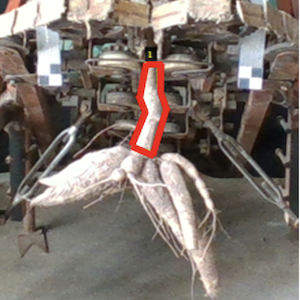 Smart Citations
Smart CitationsSee how this article has been cited at scite.ai
scite shows how a scientific paper has been cited by providing the context of the citation, a classification describing whether it supports, mentions, or contrasts the cited claim, and a label indicating in which section the citation was made.
Cassava stalk detection for a cassava harvesting robot based on YOLO v4 and Mask R-CNN
The quality of fresh cassava roots can be increased through the use of precision equipment. As a first step towards developing an automatic cassava root cutting system, this study demonstrates the use of a computer vision system with deep learning for cassava stalk detection. An RGB image of a cassava tree mounted on a cassava-pulling machine was captured, and the YOLO v4 model and two Mask R-CNN models with ResNet 101 and ResNet 50 base architectures were employed to train the weights to predict the position of the cassava stalk. One hundred test images of stalks of various shapes and sizes were used to determine the grasping point and inclination, and the results from manual annotation were compared with the predicted results. Regarding localisation, Mask R-CNN with ResNet 101 gave a significantly higher performance than the other models, with an F1 score and a mean IoU of 0.81 and 0.70, respectively. YOLO v4 showed the highest correlation for the x- and y-coordinates for the prediction of the grasping point, with values for R2 of 0.89 and 0.53, respectively. For inclination prediction, Mask R-CNN with ResNet 101 and Mask R-CNN with ResNet 50 gave the same level of correlation, with values for R2 of 0.50 and 0.61, respectively. These results were acceptable for use as design criteria for developing a cassava rootcutting robot.
Supporting Agencies
Khon Kaen UniversityHow to Cite

This work is licensed under a Creative Commons Attribution-NonCommercial 4.0 International License.
PAGEPress has chosen to apply the Creative Commons Attribution NonCommercial 4.0 International License (CC BY-NC 4.0) to all manuscripts to be published.

 https://doi.org/10.4081/jae.2023.1301
https://doi.org/10.4081/jae.2023.1301





